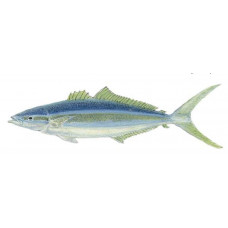Latin name
Elagatis bipinnulata
Other names
Runner, rainbow yellowtail, skipjack, shoemaker, Hawaiian salmon, prodigal son; Creole: carangue saumon, dauphin vert, sorcier; French: carangue arc-en-ciel, comère saumon; Hawaiian: kamanu; Japanese: taumuburi; Spanish: cola amarilla, corredores, macarela, pez rata, salmon, sardinata.
Identification
Body prostrate, torpedo-shaped. Head is pointed, mandibles protrude forward. Mouth small, upper jaw not reach vertical of front margin of eye. Bristle-shaped teeth are present on both jaws. The caudal fin is deeply incised. The body is covered with fine cycloid scales. No flaps in the lateral line. Rainbow runner blue-green above and white or silvery below, with a yellow or pink cast. A broad dark blue horizontal stripe runs from snout to base of tail on both sides. Immediately below it is a narrow pale blue stripe running through each eye, with a pale or shiny yellow stripe below it, and then another narrow pale blue stripe. The tail is yellow, and the rest of the fins are greenish or olive yellow. The fish has a slender body, more elongated than most other jacks. The first dorsal fin has six spines, and the second has one spine and 25-27 connected soft rays. Behind it is a two-beam fin. The anal fin has a single detached spine with 16-18 soft rays, followed by a 2 ray fin. The Rainbow runner is similar in shape to the cobia, but can be distinguished by its coloration as well as by the fins that follow the dorsal and anal fins.
Distribution
Tropical and subtropical waters of all oceans. Known catches in the Sea of Japan. Occurs worldwide in marine waters, in the western Atlantic Ocean, from Massachusetts across the northern Gulf of Mexico to northeastern Brazil. In the eastern Pacific, it is found from the mouth of the Gulf of California, Mexico, to Ecuador, including the Galápagos Islands.
Habitat
Pelagic fish of the open ocean. Usually found near the surface of the water. They form either small polarized groups or large shoals that typically stay at or near the surface, although they can inhabit depths of up to 120 feet. They occur over reefs and in deep clear lagoons, preferring areas with current.
Size
The Rainbow runner are usually 2-3 feet long, although they can reach 4 feet and 22 pounds. The world record for all-tackle fishing is held by a Mexican fish weighing 37 pounds 9 ounces. It is up to 120 cm long. Weight up to 15.2 kg. Common sizes up to 80 cm.
Life history and Behavior
No information
Food and feeding habits
They eat mainly fish. Also eat invertebrates and squid.
Reproduction
No information
| Classification | |
| Phylum | Chordata |
| Class | Actinopterygii |
| Squad | Carangiformes |
| Family | Carangidae |
| Genus | Elagatis |
| Species | E. bipinnulata |
| Features | |
| Conservation status | Least Concern |
| Habitat | Pelagic |
| Life span, years | No information |
| Maximum body weight, kg | 46.2 |
| Maximum length, cm | 180 |
| Sailing speed, m/s | No information |
| Threat to people | Edible |
| Way of eating | Predator |




